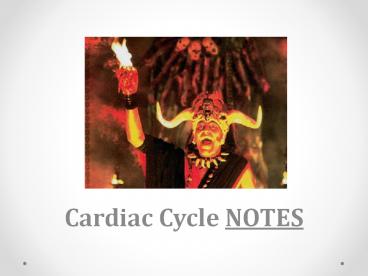Cardiac Cycle NOTES - PowerPoint PPT Presentation
Title:
Cardiac Cycle NOTES
Description:
Title: PowerPoint Presentation Author: heather lynne toad Last modified by: Im, Timothy S Created Date: 3/28/2002 1:35:52 AM Document presentation format – PowerPoint PPT presentation
Number of Views:175
Avg rating:3.0/5.0
Title: Cardiac Cycle NOTES
1
- Cardiac Cycle NOTES
2
The Cardiac Cycle
- The primary function of the heart is to circulate
oxygenated and deoxygenated blood throughout the
body.
- The RIGHT chambers of the heart carry
deoxygenated blood to travel to the lungs, where
it RELEASES CO2 and RECEIVES O2 - The LEFT chambers pump oxygenated blood back to
the bodys organs and muscles
3
REVIEW PATHWAY OF BLOOD THROUGH THE HEART
- Blood low in oxygen from the body returns to the
right atrium of the heart via the inferior and
superior vena cava - The right atrium contracts, forcing blood through
the tricuspid valve into the right ventricle. - The right ventricle contracts, closing the
tricuspid valve, and forcing blood through the
pulmonary valve into the pulmonary arteries - The pulmonary arteries carry deoxygenated blood
to the lungs to release excess carbon dioxide
(CO2) while red blood cells pick up a new supply
of oxygen (O2) - Freshly oxygenated blood returns to the left
atrium of the heart via the pulmonary veins. - The left atrium contracts, forcing blood through
the bicuspid/mitral valve into the left
ventricle. - The left ventricle contracts, closing the
bicuspid valve and forcing open the aortic valve
. Blood enters the aorta to provide oxygenated
blood to the entire body after a journey through
the blood vessels!
4
(No Transcript)
5
Cardiac Muscle Contraction
- Cardiac muscle contraction occurs in specific
steps to ensure that blood is routed to the
proper location. - Contraction is caused by action potentials
depolarizing the cardiac muscle cells leading to
sarcomere shortening
6
Remember
- Molecules do NOT like being crowded and will move
to the LESS crowded side - Depolarization Sodium (Na) IN
- Repolarization Potassium (K) OUT
7
- Cardiac Muscle Calcium (Ca) goes into cardiac
cells, prolonging depolarization, increasing
force of contraction, and increasing amount of
calcium available to initiate sarcomere
shortening (SFT)
8
(No Transcript)
9
(No Transcript)
10
Cardiac Muscle Anatomy
- Gap junctions _at_ intercalated discs allow for
rapid movement of molecules (sodium, potassium,
calcium) in and out of cell, and thus, quick
action potentials and muscle contractions
11
Cardiac Muscle Contraction
- Contraction starts at the Sinoatrial (SA) Node
which contains specialized pacemaker cells. These
cells can generate spontaneous action potentials
without input from the nervous system.
12
Pacemaker Potential
- Slow influx of Na into cardiac cells between
action potentials - Increases membrane potential positively toward
threshold potential, allowing for autorhythmicity
of cardiac cells at the SA node (all-or-none
response).
13
- Sinoatrial (SA) node (Pacemaker)
- Atrioventricular (AV)node
- Bundle of His
- Left Right Bundle branches
- Purkinje Fibers
14
Electrical Conduction System of the Heart
- SA NODE ? AV NODE ? BUNDLE OF HIS ? LEFT RIGHT
BUNDLE BRANCHES ? PURKINJE FIBERS - SA node 50 msec.
- The pacemaker.
- AV node 100 msec Atrial contraction occurs.
- AV delay Action potential travels more slowly
- This delay ensures the ventricles relax and
receive blood from atrial contraction BEFORE the
ventricles get the signal to contract and pump
blood out. - 25 msec
- Bundle of His signal travels down septum
- Right and left bundle branches depolarization
splits signal between the right and left
ventricles
15
Electrical Conduction System of the Heart
- 4. Purkinje fibers 50 msec
- Widespread fibers conduct action potentials
throughout left and right ventricles. Ventricular
contraction begins.
16
Impulse Conduction through the Heart
17
Video Clip
- http//highered.mcgraw-hill.com/sites/0072495855/s
tudent_view0/chapter22/animation__conducting_syste
m_of_the_heart.html































